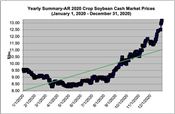|
Soybean Cash Market Ends 2020 At Lofty Heights, Levels Off In January
MONTICELLO, ARK.
Soybeans, at once Arkansas’ No. 1 crop, and the perennial symbol of the row crop farmer’s struggle for profitability – rose above $14.25 a bushel in the crop cash market at January’s mid-point.
Although prices in both the cash and booking markets have since fallen slightly – coming in at about $13.20/bu and $11.25/bu, respectively, the current market seems nearly astronomical after years in which prices commonly dwelt below $10.
Robert Stark, agricultural economist for the University of Arkansas System Division of Agriculture, said several factors are at play in the recent market rally. The Phase 1 trade agreement, signed last January, set ambitious goals for China’s purchase of U.S. agricultural products – soybeans among them. In the year that followed, an outbreak of African swine fever decimated China’s swine herds; a population the country is now trying to rebuild.
“Now they’re repopulating, so that’s building demand for soybeans as a protein source in their feed,” Stark said. “That pulls further on the global supply.”
And while global demand for soybean meal and other feed products has climbed, U.S. soybean stocks have steadily declined.
“The last few years in Arkansas, we’ve had a reduced number of acres planted,” Stark said. “In 2019, it was due to flooding events in the state – that knocked us down several hundred thousand acres. We only partially recovered in 2020, for a variety of reasons.”
Other parts of the United States have had reduced soybean production as well in the past year or two, Stark said. A straight-line windstorm, known as a derecho event, destroyed millions of acres of corn, soybeans and more in Iowa and other Midwestern states last August.
Over the past several years, the federal government has provided several forms of financial assistance to U.S. farmers. In 2019, the Market Facilitation Program provided payments to help offset declining market prices resulting from the years-long trade dispute with China. In 2020, the Coronavirus Food Assistance Program provided payments to help offset the overall decline in demand triggered by the global COVID-19 pandemic.
Stark said prices for both the cash market and booking market for soybeans and other commodities weren’t driven by those or any other federal intervention but were simply a reflection of actual market conditions.
“We have seen two payments associated with the coronavirus,” Stark said. “I’m not sure what the new administration’s position will be, as far as a third CFAP payment. I know Congress is beginning to get a little bit nervous about the amount of money that’s already been spent on stimulus payments.
“The good prices that are available for booking the 2021 crop at this point in time may actually reduce the feasibility of farmers getting an additional payment,” he said. “I think farmers, by and large, would prefer a good market price to a bad market price and a supplemental payment from the government.”
Jeremy Ross, extension soybean agronomist for the Division of Agriculture, said the high market prices will almost certainly result in higher Arkansas soybean acreage in 2021, although much of the success in planting those acres will depend on winter and spring weather.
“We’re still two or three months away from planting, but farmers still need to get the ground ready to plant,” Ross said. “That’s probably at the forefront of everyone’s thoughts. We need dry weather so we can get fields ready.”
As of 10 a.m. Monday, Jan. 25, much of the state has seen substantial rainfall, likely further delaying fieldwork. ∆

Throughout 2020, soybean cash market prices saw a low of $8.31/bu. By the year's end, they had risen about $13/bu. As of mid-January 2021,
soybeans were booking at more than $14/bu.
Division of Agriculture graphic
|
|